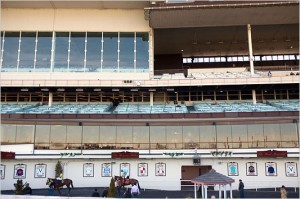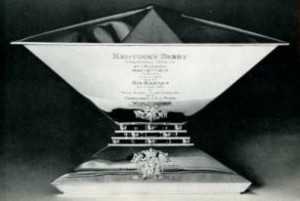After indulging in stories of spilled sushi and perusing pictures of the lovely Beulah Twins (RIP Beulah), its time for the ThoroBros to focus their attention on the business of the sport. This post is the first in a series of posts about the state of the live on-track experience and a critical analysis of what we think can be done to have thoroughbred racing regain a foothold in the year-round national sporting consciousness.
Let’s start with the stark reality: when people thought about the racetrack in the 50s, 60s and 70s, they thought of scenes like this:
That is a picture from Bay Meadows in 1951 — on a stakes race day, but certainly not the Kentucky Derby. Now, when people think of horse racing, many imagine scenes like this:
Or, if they are the average person living in Maryland, they think that horse racing occurs once a year, and is merely side entertainment to the main event:
Let’s hope that gentleman is ok.
In any event, when your sport is associated with empty venues and morons running across port-a-potties, you have a problem. But the fundamental questions are: (i) how big a problem does the sport have? and (ii) how do we, as a sport, fix it?
Those two questions are far too wide ranging to answer in one blog post. So in this installment of the ThoroBros Business Review, we will briefly lay out our view of the scope of the sport’s attendance/interest problems and briefly discuss the two major things that people cite when they talk about the potential for a brighter future. Beyond that, you will have to wait for next week (Please come back next week. It’s a new blog. We are begging you).
It is indisputable that on-track attendance is suffering, and suffering badly. Pretty much every person involved in the sport has expressed concern about this trend and has put forward ideas for reversing it. What has been less covered is whether interest in the sport is waning from a “dollars wagered” perspective. People are betting on the sport, it’s just that they are no longer going to the track to do it. Andy Beyer covered this phenomenon well in his September 2013 article titled “The stands may be empty, but people are betting.” (http://www.drf.com/news/andrew-beyer-stands-may-be-empty-people-are-betting). Who could blame the bettors? If you are trying to bet seriously, and reap the benefits of rebates provided by ADW providers, why would you go to the track? Stay in the comfort of your home, watch on TV, and bet four tracks at once. The onus now falls on track owners and operators to make the ontrack experience desirable again. It does not appear that there has been much progress in that regard.
With respect to how things could turn around, two things are often pointed-to as “silver bullets” that can save the sport, or go a long way to saving the sport, in one fell swoop. The first is a Triple Crown winner. The ThoroBros are hoping that we can test the veracity of that hypothesis beginning at about 7:00 pm EDT on June 7, 2013. We do not believe that California Chrome winning the Belmont will, in and of itself, revive horse racing. It will, however, provide a brief window of great publicity — the industry must grab that window and take full advantage of it. In the coming week, the ThoroBros will discuss how best to do that, should California Chrome prevail.
The second “silver bullet” is that a central governing authority for the sport will get all the tracks in line, harmonize medication rules, make the tracks work with one another on racing dates and stakes schedules and otherwise springboard the sport into the 21st century.
We believe there is some merit to both hypotheses, but believe that both are too simple. Too frequently in this sport, enthusiasts believe that the answer is right around the next corner, and all of a sudden, the majesty of thoroughbred racing will capture the nation’s attention once again. We believe in racing. We think that if you get enough people to come to the track, and make their experience at the track exciting and enjoyable, many of them will become fans. But it will require work on the part of all the stakeholders — and it will require working together. A central governing authority will go a long way in this regard, but it would be no silver bullet.
We think that everyone in the racing community has a role to play, and here are some things that we think would improve the popularity of the sport right off the bat:
- make wagering easier to understand — there is a ton of jargon in the sport that the average person cannot simply pick up;
- make the on-track experience more fan friendly, perhaps by including (nice) restaurants, bars, and other amenities on track (the ThoroBros were encouraged by NYRA’s recent hire of Lynn LaRocca as CXO);
- market the sport to the demographic most likely to become lifelong fans (in our view, that is 20-35 year old males);
- create easy-to-follow divisions and stakes series to bridge the gap between the Triple Crown series and the Breeders’ Cup;
- decrease the amount of time between races on a typical race day (we understand this could potentially negatively impact handle in its initial stages, but people would get used to it; the fact of the matter is that people are more likely to set aside 3 hours of their Saturday to go to the track rather than 6).
We think those are some simple ideas to start with. Next week we will examine some ideas for centralizing the governance of the sport.
Go Chrome!





Well done except the thought about compressing time. Of you want the crowd to keep coming back you need to let them win and with late scratches, weather and other issues that need to be considered I can’t agree with a 50 percent time compression